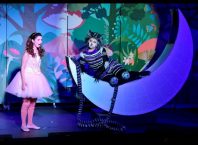Like many other Israelis who have visited Berlin in recent years I was captivated by the outward appearance of the city: its beautiful streets, manicured parks and orderly life-style. And then there is the vibrant cultural scene that has drawn so many Israeli artists to live and work in this city. Easiest for all to put its terrible history behind them.
But for the 17 Israeli and international artists participating in the exhibition Back to Berlin, this stance is not an option. The works they show here – photos, video pieces, paintings and mixed media installations – delve into the city’s past and revive old memories. Two themed group shows and two solo shows are displayed under this umbrella title.
Seven artists are showing their work in the group show Re-View, curated by Aya Lurie, the new director of Herzliya Museum. Historical research is the common denominator. In this review, I have just made reference to two out of many fine exhibits that make such a powerful impression.
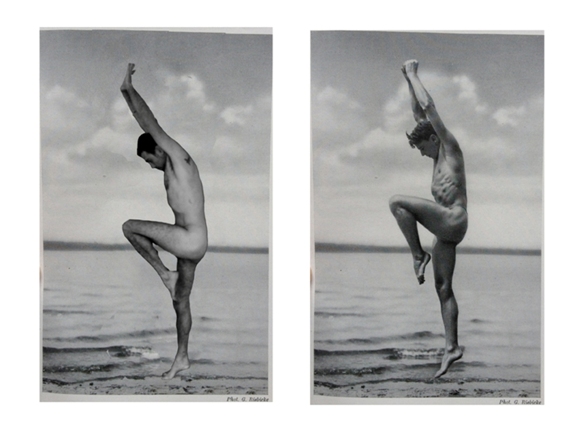
Erez Israeli (who worked in Germany in 2013) hones in on the Nazis’ obsession with the perfect Aryan body. Displayed on the shelves of the gallery are open pages from the book Der Mensch und die Sonne (Man and Sun). Written by Hans Surén in 1924 it became a best-seller in Germany. The sentiments it promotes – that sunshine, nudity and health were the path to happiness – were enthusiastically adopted by the Nazi party. On pages where the text is illustrated by photos of nude youths showing off their toned bodies, Israeli has substituted images of himself in identical poses. Inevitably one compares his figure with that of the man in the original photographs. This comparison refutes the Nazis’ conviction that one could distinguish between superior and inferior racial types.
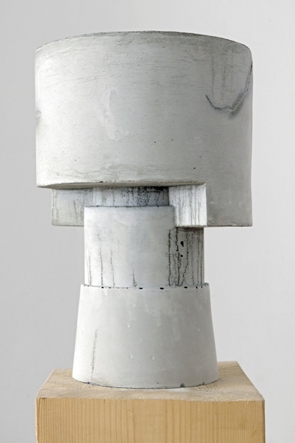
Among the wealth of objects and artifacts that Ella Littwitz, (resident in Berlin since 2010) has researched in Germany are the concrete, one-person bunkers built cross country during World War II; their purpose being to protect individuals crucial to the war effort. Another focus of her interest, illustrated here as a miniaturized model that she labels Structure T, is the monumental Schwerbelastungskörper – a heavy load-bearing body. Erected in 1941 in central Berlin to test the strength of a site where architect Alfred Speers intended to put up a Victory Arch for Germania, Hitler’s proposed super capital of the world. Today this building, still in situ, proving too difficult to uproot, has become a monument to Nazi megalomania.
Thomas Mann’s Dr Faustus, a landmark in modern German literature that tells the story of a man who sells his soul to the devil is the entry point into the second group show. Mann, who wrote this book in 1947, employs this story as an allegory for the rise of the Nazi party and for investigating social- political conditions that led to World War II.
Taking their cue from the Faustus’ story, the seven local and international artists taking part in this exhibition have chosen to manipulate seminal works of art, music or film in order to shed light, like Thomas Mann, on the spirit of those times, or else, to highlight negative social traits which are still in evidence in Germany of today. Video is their medium, with outstandingly original results.
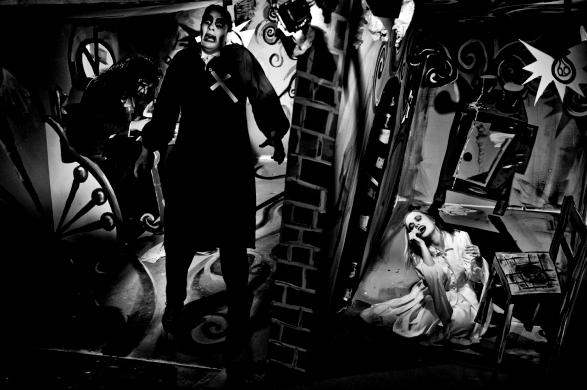
I found In the Shadow of the Maggot (2010) produced by multi-media German artist John Bock to be especially enthralling. This films with its crazy characters, dizzy, sharp-edged staging and terrifying stage props looks back to non-conformist art movements of the 1920s, as well as to early German movies like the silent, black-and-white horror film The Cabinet of Dr. Caligari.
In his book From Caligari to Hitler, Siegfried Kracauer, a well known film critic who fled Germany in 1933, suggested that “the rise of Nazism was foretold by the preceding years of German films, which reflected a world of wrong angles and lost values.” Within the context of this show, this could well be Bock’s message.
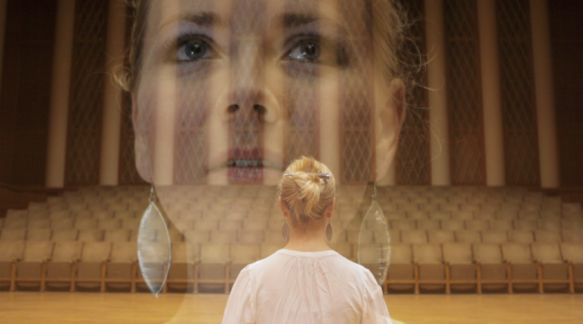
Amir Fattal (resident in Berlin, and co-curator with Stephen Köhler of the ‘Faustus’ exhibition) came up with an especially clever idea. He re-orchestrates the aria from Richard Wagner’s Tristan and Isolde, sung by Isolde after Tristan’s death, reversing the order of the composition so that the final note becomes the first. In creating this new version of a work by Wagner, a virulent anti-Semite, is Fattal suggesting that the history of Germany in the last century could have been re-written, with its citizens choosing life over death and the destruction?.
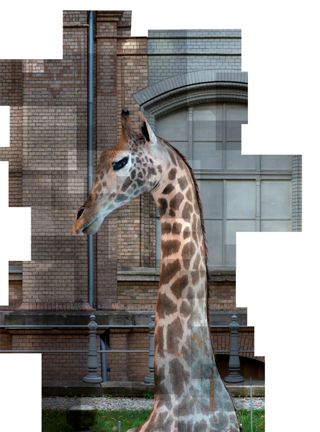
In the Museum’s largest gallery the first of two solo shows are on exhibit. This one, titled Implicit Manifestations and curated by Aya Lurie, is the outcome of a project undertaken by Israeli artist Ilit Azoulay in 2013, during a six-month residency in Berlin at KW Institute for Contemporary Art. Simultaneously, the same installation but with a different title, is now being shown in Berlin at the Institute.
On view here are huge panoramic photographs of objects, artifacts and architectural elements that Azoulay located, researched and photographed. They were mostly found in Berlin, but also in other German cities. The photographed items are spread out across one long wall. In the central space of the gallery, the same images in different sizes have been integrated into scenes showing the internal spaces of the KW institute at a time when reconstruction work was taking place in the building.
To hear Azoulay describing her efforts to gather information about these objects – some of which are grotesque like a gargoyle in the shape of a barking dog’s head, some mysterious like a cardboard package containing a fossil – it is necessary to loan earphones from the Museum’s front desk. As regards the stuffed head and neck of a giraffe illustrated above, this item was located by Azoulay in a Cabinet of Curiosities in Berlin. Here, in Israel, the museum has temporarily become her personal Cabinet of Curios. It is a joy to study.
After viewing the many exciting works on display, the second solo show comes across as low key in character. Curated by Sapir Hubermann and titled Visitors Book- Photos from a Personal Archive, it features black and white photos from a huge collection amassed by German photographer Erich Schiemann while visiting concentration and extermination camps. Here he has sought out relics of life, hidden corners in the buildings and small details of symbolic interest, like a stairway going nowhere. There are black and white portraits too: unassuming studies of people who work there or have come to visit.
A separate exhibition features massive sculptures by Zvi Lachman – a major lsraeli artist known for his craggily expressive figures, usually cast in bronze. At first it seemed to this writer that their presence, theme-wise, was currently out place. But then I realized something significant. Lachman’s sculpted heads and especially his massive piece Carrying – Pieta (It. pity) – that takes inspiration from Michelangelo’s representations of the Virgin Mary mourning over the dead body of Jesus – evoke the same feelings of sadness and loss that emanate from many of the works brought together for the main show: Back to Berlin.
Also participating are Shy Abady, Andy Graydon, Mattias Härenstam, Andy Hope 1930, Hajnal Németh, Alona Rodeh,Amie Segal, Ariel Schlesinger, Amir Yatziv, Ming Wong and Maya Zack
Herzliya Museum of Contemporary Art, 4 Habanim St., Herzliya. Till January 17th.





